Roches volcaniques et magmatiques. Volcanic and magmatic rocks
- Galerie virtuelle de Jean-Pierre Milesi, Artiste contemporain
- Sélection sur : https://www.artlimited.net/milesijp
Volcanites
AGO. Basalte, St Flour, Cantal, 2024
Nature : Basalte infracantalien de la région de St Flour (8,8+-0,5 Ma).
Géologie : « La coupe des Orgues de Saint-Flour … montre un entablement épais à faux-prismes fasciculés surmontant une colonnade régulière. La lave de l’entablement est très riche en verre brun (mais les microlites de plagioclase y sont déjà largement représentés), celle de la colonnade est bien cristallisée, mais altérée, et les péridots y sont totalement serpentinisés…. ». (http://ficheinfoterre.brgm.fr/Notices/0789N.pdf)
Localisation : « La ville de Saint-Flour est construite sur une coulée basaltique antérieure à l’édification du stratovolcan cantalien proprement dit (basaltes infracantaliens) et donc aux coulées qui cuirassent la planèze de Saint-Flour (basaltes supracantaliens) ». https://avg85.fr/wp-content/uploads/2015/06/Pages-de-Diaporama-Excursion-géologique-dans-le-Cantal-3.pdf
« Les Orgues de Saint-Flour, constituent la partie inférieure (colonnade régulière) d’une coulée basaltique qui a empruntée il y a 8,8+/-0,5 Ma une portion de la paléo-vallée de l’Ander, du Sud-Est vers le Nord-Ouest. Cette coulée (dite coulée inférieure de Saint-Flour) est aujourd’hui découpée en 4 morceaux, répartis sur près de 9 km : le lambeau de « Le Saillant » – la coulée inférieure de Saint-Flour sur laquelle s’est développée la vieille ville – le « Plateau de Chaumette » – le culot de Grisols ». https://inpn.mnhn.fr/site/inpg/AUV0062/tab/descGeologique
Utilisation : Architecture, travaux public, sculpture.
Dimensions : 22x18x10cm – 7,4 Kg
Bibliographie :
http://ficheinfoterre.brgm.fr/Notices/0789N.pdf
https://inpn.mnhn.fr/site/inpg/AUV0062/tab/descGeologique
https://avg85.fr/wp-content/uploads/2016/03/Segment-004-de-AVG.Bulletin-2015-Copie.pdf
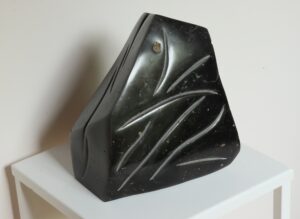
Dos à Dos. Back to back, Basalte, région d’Agde. 2019
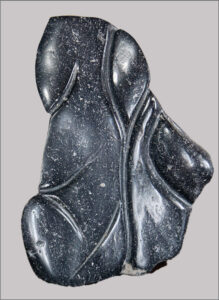
Nature : Basalte. 2019.
Localisation : Roche de la région d’Agde, ce basalte est une roche « volante » (qui ne vole pas ; mais qui a été trouvée sur un chemin !). Ce basalte est issu des volcans d’=u Cap d’Agde.
On the beach in the region of Agde, France, some artists take superb photos of subtly naked naiads.
No luck, I only found this basalt. Block « flying » (which means for a geologist that it is not in place), evoking silhouettes.
Géologie : Lave basaltique.
Technique : Sculpture à vitesse lente.
Dimensions : ~22x18x10 cm ; poids : 4,7 Kg.
Nature: Basalt. 2019.
Location: Rock from the Agde region, this basalt is a “flying” rock (which does not fly; but which was found on a path!). This basalt came from perhaps? from the Agde volcano or rather from the Massif Central (reported rock).
On the beach in the region of Agde, France, some artists take superb photos of subtly naked naiads.
No luck, I only found this basalt. Block ‘flying’ (which means for a geologist that it is not in place), evoking silhouettes.
Geology: Basaltic lava .
Technique: Slow speed carving.
Dimensions: ~22x18x10 cm; weight: 4.7 kg
Loup-renard, Wolf-Fox, Basalte, 2019
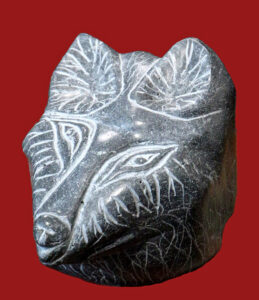
Pyroclastites & volcanites, Cantal, France, 2022
Igni, Pyroclastites, Alagnon, Cantal, France, 2022
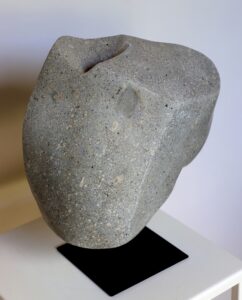
Dimensions : 26x22x10 cm – 7.0 Kg
« Phono lune », Phonolite, Cantal, France, 2022
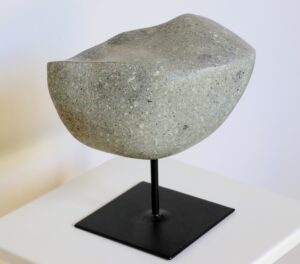
Dimensions (HxLxP) : 11x21x9 cm – 2,83 Kg
____________________________________________________________________
Roches magmatiques – Magmatic rocks.
Greenstone, Mexique. 2021.
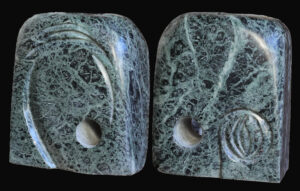
Vert Olmèque. Volcanite, Greenstone, Mexique, 2021 (nature et provenance incertaines)
« Brèches du Bénou », Pyrénées, France
Faune de Bénou et Végétaux, Carrière de Bénou
Satyr and Plants, Bénou Quarry, Pyrénées, Pyrenees, France, 2018
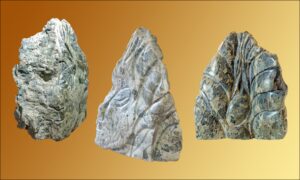
Nature : Brèche verte (calcaro-magmatique ?). 2018.
Localisation : Carrières de Brèches du Bénou, Bielle, Pyrénées-Atlantiques, France.
Géologie :
La faille du plateau de Bénou, est constituée de : brèches et d’écailles tectoniques, de terrains variés (schistes du Silurien, calcaires du Trias, du Jurassique et du Crétacé) et de roches basiques intrusives : ophites et lherzolithes (https://sigesaqi.brgm.fr/).
Technique : Sculpture par abrasion à vitesse lente.
Ce faune est né suite à un bris de la roche : la pierre ayant une forme en « V » avec une bosse au centre, l’idée première était celle d’un papillon. Hélas, la tête s’est brisée me laissant une sorte de graine, que j’ai entouré d’une sorte de feuillage.
Puis, tournant la pierre, une faille à stries horizontales est apparue favorisant la cristallisation de pyrite (sulfure de fer). La plus grosse pyrite, centimétrique, avait été dissoute lors de l’oxydation de la roche et laissait un trou, un œil. Réunir le décor végétal arrière et cette face s’est imposé alors, car un profil de personnage se dessinait naturellement avec « front », « nez », « lèvre ». Un « faune barbu » a été une solution.
Dimensions : ~45x35x22 cm ; poids : 33,9 Kg.
Bibliographie : https://sigesaqi.brgm.fr/.
Nature: Green breccia (calcaro-magmatic?). 2018.
Location: Carrières de Brèches du Bénou, Bielle, Pyrénées-Atlantiques, France.
Geology:
The Bénou plateau fault is made up of: breccias and tectonic scales, varied terrains (Silurian shales, Triassic, Jurassic and Cretaceous limestones) and intrusive basic rocks: ophites and lherzoliths (https:// sigesaqi.brgm.fr/).
Technique: Slow speed abrasion carving.
This fauna was born following a break in the rock: the stone having a “V” shape with a bump in the center, the first idea was that of a butterfly. Alas, the head broke, leaving me a sort of seed, which I surrounded with some sort of foliage.
Then, turning the stone, a fault with horizontal streaks appeared favoring the crystallization of pyrite (iron sulphide). The largest pyrite, centimeter in size, had been dissolved during the oxidation of the rock and left a hole, an eye. Bringing together the rear plant decoration and this face became essential, because a character profile was naturally drawn with ‘forehead’, ‘nose’, ‘lip’. A “bearded faun” was a solution.
Dimensions: ~45x35x22 cm; weight: 33.9 kg.
Bibliography: https://sigesaqi.brgm.fr/.
« Dolérites », Plougrescant, Côtes-d’Armor, France
Localisation : Dans la région de Plougrescant, Côtes-d’Armor, France, des dykes de roches magmatiques de semi-profondeur dites « dolérites », d’âge Paléozoïque, recoupent des granites d’âge Néoprotérozoïque (615 Ma).
Nature : Roches magmatiques basiques microgrenues (gabbros et dolérites)
Géologie : Dans la région de Plougrescant, Côtes-d’Armor, France, des dykes de roches magmatiques de semi-profondeur dites « dolérites », d’âge Paléozoïque, recoupent des granites d’âge Néoprotérozoïque (615 Ma).
« Connues dans la littérature scientifique sous l’appellation de « dolérites du Trieux », ces roches magmatiques microgrenues se rencontrent généralement sous forme de filons de quelques mètres de largeur. C’est notamment le cas à Plougrescant, dans la vallée du Jaudy et au niveau de l’embouchure du Trieux, où ces filons constituent un véritable réseau, recoupant les roches encaissantes à l’emporte-pièce. Sur le littoral, on peut parfois les suivre sur plusieurs centaines de mètres, leur teinte sombre permettant de les repérer facilement dans le paysage granitique beaucoup plus clair. De manière générale, les filons de dolérite représentent les conduits d’alimentation d’un magma à composition basaltique, canalisé à travers la croûte terrestre depuis le manteau jusqu’à la surface, le plus souvent pendant des phases d’extension et d’amincissement de cette croûte alors fragilisée. Si ces conduits apparaissent aujourd’hui sous nos yeux, c’est grâce au travail de l’érosion qui décape inexorablement les terrains superficiels, mettant ainsi au jour des objets géologiques formés en profondeur il y a quelques millions d’années. Ici, à l’extrémité la plus septentrionale de la Bretagne, ces nombreux filons ont été injectés au début du Paléozoïque au sein d’un socle granitique qui s’est mis en place il y a environ 615 millions d’années. Ils témoignent de générations magmatiques successives au cours d’une période de distension du socle, les plus anciens de ces filons étant recoupés et fragmentés par les plus récents. » In BRE0134 – Filons de dolérite paléozoïques du Gouffre de Plougrescant – Description géologique (mnhn.fr)
Technique : Meuleuse d’angle. Meuleuse droite. Abrasion lente.
Bibliographie : BRE0134 – Filons de dolérite paléozoïques du Gouffre de Plougrescant – Description géologique (mnhn.fr)
Location: In the Plougrescant region, Côtes-d’Armor, France, dykes of semi-deep magmatic rocks called ‘dolerites’, of Paleozoic age, cut granites of Neoproterozoic age (615 Ma).
Nature: Micro-grained basic magmatic rocks (gabbros and dolerites)
Geology: In the Plougrescant region, Côtes-d’Armor, France, dykes of semi-deep magmatic rocks called ‘dolerites’, of Paleozoic age, cut granites of Neoproterozoic age (615 Ma).
‘Known in the scientific literature under the name ‘Trieux dolerites’, these micro-grained magmatic rocks are generally found in the form of veins a few meters wide. This is particularly the case at Plougrescant, in the Jaudy valley and at the mouth of the Trieux, where these veins constitute a real network, intersecting the surrounding rocks with a punch. On the coast, you can sometimes follow them for several hundred meters, their dark color making it easy to spot them in the much lighter granite landscape. Generally speaking, dolerite veins represent the supply conduits of a magma with a basaltic composition, channeled through the earth’s crust from the mantle to the surface, most often during phases of extension and thinning. of this then weakened crust. If these conduits appear before our eyes today, it is thanks to the work of erosion which inexorably strips away the surface areas, thus revealing geological objects formed at depth a few million years ago. Here, at the northernmost extremity of Brittany, these numerous veins were injected at the beginning of the Paleozoic within a granite base which was established around 615 million years ago. They bear witness to successive magmatic generations during a period of distension of the base, the oldest of these veins being cut and fragmented by the most recent.’ In BRE0134 – Paleozoic dolerite veins from the Gouffre de Plougrescant – Geological description (mnhn.fr)
Technique: Angle grinder. Straight grinder. Slow abrasion.
Bibliography: BRE0134 – Paleozoic dolerite veins from the Gouffre de Plougrescant – Geological description (mnhn.fr)
Marius M, gabbro, Plougrescant, Côtes d’Armor, France, 2017.
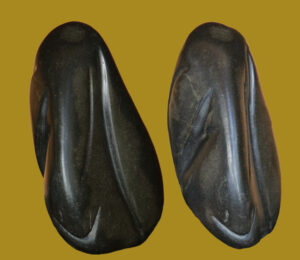
Dimensions : 18x11x7 cm – Poids : 2,64 Kg
Regard vert. Green gaze. Dolérite, Plougrescant, Côtes d’Armor, France, 2017.
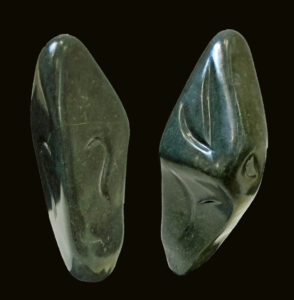
Dimensions : 32x12x10 cm – Poids : 6,40 Kg
Ultrabasites, ultrabasic rocks.
Près de Châtillon, Aoste (Italie) affleurent des serpentinites (roches ornementales dites « vert antique », « marbre vert d’Italie », « vert d’Italie », ou « Verde Issogne ».), faisant partie des ophiolites alpines du Val d’Aoste. l’affleurement est une « brèche tectonique », constituée d’éléments de serpentinite foliés et plissée, en forme de fuseaux emballés dans une « matrice » également serpentineuse.
Ces roches sont issues de l’altération hydrothermale de roches ultrabasiques (cf. Pierre Thomas, 2014 in https://planet-terre.ens-lyon.fr/ressource/Img446-2014-01-13.xml). Les fragments de texte cités ci-après sont issus de l’article de Pierre Thomas. »
Near Châtillon, Aosta (Italy), serpentinites (ornamental rocks called “antique green”, “Italian green marble”, “Italian green”, or “Verde Issogne”) outcrop, forming part of the alpine ophiolites of Val of Aosta. the outcrop is a ‘tectonic breccia’, made up of foliated and folded serpentinite elements, shaped like spindles packed in an equally serpentine ‘matrix’.
These rocks come from the hydrothermal alteration of ultrabasic rocks (cf. Pierre Thomas, 2014 in https://planet-terre.ens-lyon.fr/ressource/Img446-2014-01-13.xml). The fragments of text cited below come from the article by Pierre Thomas.’
« Les serpentinites sont des roches constituées majoritairement de minéraux de la famille des serpentines (formule : (Mg,Fe)3Si2O5(OH)4.) ».
« La très grande majorité des serpentinites provient de l’altération hydrothermale de roches ultrabasiques, et plus particulièrement de leur olivine : olivine [(Mg, Fe)2SiO4] + H2O donnant serpentine [(Mg,Fe)3Si2O5(OH)4] + magnétite [Fe3O4] + brucite [Mg(OH)2 ]+ H2 … ».
‘Serpentinites are rocks made up mainly of minerals from the serpentine family (formula: (Mg,Fe)3Si2O5(OH)4.)’.
‘The vast majority of serpentinites come from the hydrothermal alteration of ultrabasic rocks, and more particularly from their olivine: olivine [(Mg, Fe)2SiO4] + H2O giving serpentine [(Mg,Fe)3Si2O5(OH)4] + magnetite [Fe3O4] + brucite [Mg(OH)2 ]+ H2 …’.
Principaux gisements :
- « Sommet du manteau sous la croûte océanique, ou directement au contact avec l’eau de mer ou les sédiments dans le cas des dorsales qui fonctionnent sans magmatisme et des marges correspondantes ;
- Même contexte de formation, non pas en place au fond de l’océan mais inclus dans les montagnes sous formes d’ophiolites ;
- Fragments de manteau sous-continental incorporés dans les chaînes de montagne lors de phénomènes de collisions ;
- Cumulats de fond d’intrusions basiques intracontinentales. »
« Dans le second cas, l’altération hydrothermale est soit océanique (comme dans le premier cas), soit continentale (soit les deux). En effet, une nappe ophiolitique se met en place lors de phénomènes de collision ; elle est souvent prise en « sandwich » entre deux éléments de croûte continentale, hydratée ; l’eau issue des fragments de croûte continentale peut alors circuler et hydrater la fraction péridotitique de la nappe ophiolitique. »
Main deposits:
- ‘Top of the mantle under the oceanic crust, or directly in contact with seawater or sediments in the case of ridges that operate without magmatism and corresponding margins;
- Same formation context, not in place at the bottom of the ocean but included in the mountains in the form of ophiolites;
- Fragments of subcontinental mantle incorporated into mountain ranges during collision phenomena;
Background accumulations of intracontinental basic intrusions.’
‘In the second case, the hydrothermal alteration is either oceanic (as in the first case) or continental (or both). Indeed, an ophiolitic layer is created during collision phenomena; it is often sandwiched between two elements of hydrated continental crust; water from fragments of continental crust can then circulate and hydrate the peridotitic fraction of the ophiolitic layer.’
Platée, Serpentinite, Châtillon, Val d’Aoste, Italie. 2021

Nature : « Verde Issogne », ultrabasite serpentinisée. 2021.
Localisation : Châtillon, Aoste, Italie.
Géologie : Cette roche fait partie des ophiolites alpines du Val d’Aoste. Il s’agit de fragments de croûte océanique (à roches ultrabasiques (péridotites)), transportés par obduction sur un continent.
Ces ultrabasites y ont été serpentinisées. (Les serpentinites sont des roches constituées principalement de minéraux de la famille des serpentines, formule : (Mg, Fe)3Si2O5(OH)4).
La serpentinisation est un processus d’altération hydrothermale affectant plus particulièrement de leur olivine : olivine [(Mg, Fe)2SiO4] + H2O donnant serpentine [(Mg, Fe)3Si2O5(OH)4] + magnétite [Fe3O4] + brucite [Mg(OH)2 ]+ H2.
Technique : Sculpture guidée par la texture de la roche, et par la forte fracturation de la roche.
Dimensions : ~25x30x20 cm ; poids : 16,7 Kg.
Bibliographie :
THOMAS Pierre, 2014 in https://planet-terre.ens-lyon.fr/ressource/Img446-2014-01-13.xml).
PERRIER R. : Les marbres verts du Val d’Aoste, Le Mausolée, n° 704, avril 1995, p. 58-71 in http://roches-ornementales.com/Site-Aoste/VALDAOSTE.HTML
Nature: “Verde Issogne”, serpentinized ultrabasite. 2021.
Location: Châtillon, Aosta, Italy.
Geology: This rock is part of the Alpine ophiolites of the Aosta Valley. These are fragments of oceanic crust (with ultrabasic rocks (peridotites)), transported by obduction to a continent.
These ultrabasites have been serpentinized there. (Serpentinites are rocks made up mainly of minerals from the serpentine family, formula: (Mg, Fe)3Si2O5(OH)4).
Serpentinization is a process of hydrothermal alteration affecting more particularly their olivine: olivine [(Mg, Fe)2SiO4] + H2O giving serpentine [(Mg, Fe)3Si2O5(OH)4] + magnetite [Fe3O4] + brucite [Mg (OH)2 ]+ H2.
Technique: Sculpture guided by the texture of the rock, and by the strong fracturing of the rock.
Dimensions: ~25x30x20 cm; weight: 16.7 kg.
Bibliography:
THOMAS Pierre, 2014 in https://planet-terre.ens-lyon.fr/ressource/Img446-2014-01-13.xml).
PERRIER R.: The green marbles of Val d’Aosta, Le Mausolée, n° 704, April 1995, p. 58-71 in http://roches-ornementales.com/Site-Aoste/VALDAOSTE.HTML
A écouter et voir : Opéra « Platée » de Rameau avec, dans le rôle de la grenouille Platée, Paul Agnew époustouflant, direction Marc Minkowski.
To listen and see: Opera ‘Platée’ by Rameau with, in the role of the frog Platée, a breathtaking Paul Agnew, directed by Marc Minkowski.
L’Appel, Serpentinite, Verde Issogne, Châtillon, Aoste, Italie
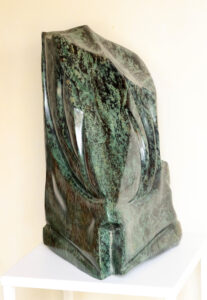
Albitites
https://hal.archives-ouvertes.fr/insu-01388150: Marion Guinault, Erwan Hallot, Philippe Boulvais, Marc Poujol, Michel de Saint Blanquat, Philippe Rémy. L’albitisation dans le granite de Lansac-St Arnac : paroxysme de la métasomatose sodique pyrénéenne au Crétacé
Dans le granite de Lansac-St Arnac et son encaissant gneissique (Massif de l’Agly, Pyrénées Orientales, France), l’albitisation des roches résulte de la circulation de fluides d’origine crustale ou de surface. Dans ces granites, la dissolution du quartz (épisyénitisation) précède la métasomatose sodique (albitisation). L’albitisation, datée entre 108 et 96 Ma, dans le granite de Lansac- St Arnac constitue le paroxysme de l’altération sodique albo-cénomanienne dans les Pyrénées. Le contexte géodynamique crétacé des Pyrénées – extension lithosphérique entrainant l’exhumation de roches mantelliques en surface et fort flux de chaleur associé – est particulièrement propice à la mise en circulations de fluides géologiques sur des échelles régionales. L’albitisation est suffisamment développée pour faire l’objet d’une exploitation industrielle.
https://lithotheque.ens-lyon.fr/Lithotheque/FormRech/page.php?recup=A88.2
On trouve plusieurs petits massifs d’albitite dans l’Est des Pyrénées. Ces albitites sont d’origine métasomatique (percolation de fluides hydrothermaux hyper-alcalins). Elles sont localisées dans des zones tectoniquement actives et se forment généralement au dépend de granitoïdes, gneiss ou micaschistes hercyniens (ici granite de Saint Arnac). L’albitisation conduit au remplacement des feldspaths par de l’albite et à la disparition du quartz. Elle peut être associée à la cristallisation de muscovite. Ces albitites se sont formées lors de l’événement métamorphique Nord-pyrénéen (métamorphisme de haute température et basse pression) à la limite du Crétacé inférieur et du Crétacé supérieur.
https://www.geosoc.fr/metiers-formations/domaines-d-activites/ressources-minerales/pour-en-savoir-plus/geologie-miniere/284-feldspaths-du-sud-imerys/file.html
https://lasim.org/images/doc_gratuite/les-feldspaths.pdf : Usage des feldspath bien documenté.
https://hal.archives-ouvertes.fr/insu-01388150: Marion Guinault, Erwan Hallot, Philippe Boulvais, Marc Poujol, Michel de Saint Blanquat, Philippe Rémy. Albitization in the Lansac-St Arnac granite: paroxysm of Pyrenean sodium metasomatosis in the Cretaceous
In the Lansac-St Arnac granite and its surrounding gneissic (Agly Massif, Pyrénées Orientales, France), the albitization of the rocks results from the circulation of fluids of crustal or surface origin. In these granites, the dissolution of quartz (episyenitization) precedes sodium metasomatosis (albitization). Albitization, dated between 108 and 96 Ma, in the Lansac-St Arnac granite constitutes the paroxysm of Albo-Cenomanian sodic alteration in the Pyrenees. The Cretaceous geodynamic context of the Pyrenees – lithospheric extension leading to the exhumation of mantle rocks on the surface and strong associated heat flow – is particularly conducive to the circulation of geological fluids on regional scales. Albitization is sufficiently developed to be the subject of industrial exploitation.
https://lithotheque.ens-lyon.fr/Lithotheque/FormRech/page.php?recup=A88.2
There are several small albitite massifs in the eastern Pyrenees. These albitites are of metasomatic origin (percolation of hyper-alkaline hydrothermal fluids). They are located in tectonically active zones and are generally formed from granitoids, gneisses or Hercynian mica schists (here Saint Arnac granite). Albitization leads to the replacement of feldspars by albite and the disappearance of quartz. It may be associated with the crystallization of muscovite. These albitites were formed during the North-Pyrenean metamorphic event (high temperature and low pressure metamorphism) at the boundary of the Lower Cretaceous and the Upper Cretaceous.
https://www.geosoc.fr/metiers-formations/domaines-d-activites/ressources-minerales/pour-en-savoir-plus/geologie-miniere/284-feldspaths-du-sud-imerys/file.html
https://lasim.org/images/doc_gratuite/les-feldspaths.pdf: Well-documented use of feldspar.
ALBA, Albitite, Arnac, Pyrénées orientales, Eastern Pyrenees, France, 2021
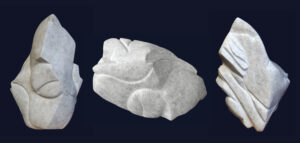
Nature : Albitite de St Arnac. 2021.
Localisation : Carrière de St Arnac (Massif de l’Agly, Pyrénées Orientales).
Géologie : cf. plus haut
Technique : Sculpture par abrasion à vitesse lente.
Dimensions : ~19x33x13 cm ; poids : 14,5 Kg.
Nature: Albitite from St Arnac. 2021.
Location: St Arnac quarry (Agly Massif, Eastern Pyrenees).
Geology: cf. upper
Technique: Slow speed abrasion carving.
Dimensions: ~19x33x13 cm; weight: 14.5 kg.
ALBI, Albitite, Arnac, Pyrénées orientales, Eastern Pyrenees, France, 2018
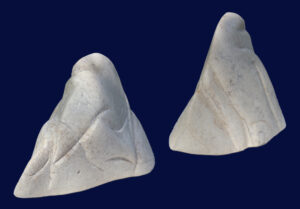
Granitoïdes, Granitoids
Noble granite, Granite « de bordure de trottoir », Curbside granite. 2016
Ce morceau de granite m’a été aimablement donné par un employé communal, car il était cassé. cette cassure a déterminé la réalisation. Pourquoi est-il « noble »? Ce n’est pas du a la beauté de la roche, sans doute granite du Portugal, ni de la partie crêtée, « couronnée ». Mais uniquement par ses deux particules : il s’agit d’un granite de bordure de trottoir.
This piece of granite was kindly given to me by a municipal employee because it was broken. this break determined the achievement. Why is he « noble »? This is not due to the beauty of the rock, undoubtedly granite from Portugal, nor of the crested, « crowned » part. But only by its two particles: it is a sidewalk granite (french joke due to 2 particules: « de bordure de trottoir »).
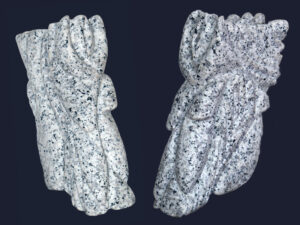
Insolite lilac, Unusual lilac, granitoïde, granitoid, 2017
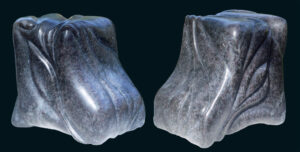
Syénite néphélinique. Nepheline-bearing syenite
Nature : Syénite à néphéline (roche plutonique constituée de feldspaths alcalins et sodiques et de néphéline).
Localisation : Fitou, Aude, France.
Géologie : « Le massif de Fitou (1 000 X 400 m) apparaît en regard sous la série mésozoïque de la « nappe » des Corbières. Il est localement intrusif dans les terrains triasiques de ce regard et se trouve en contact anormal avec les différents termes de la série secondaire décollée (Trias à l’Urgonien) » (in A. VITRAC-MICHARD, F. ALBARÈDE et B. AZAMBRE, Age Rb-Sr et 39Ar-40Ar de la syénite néphélinique de Fitou, Bull. Soc. fr. Minéral. Cristallogr., (1977), 100, 251-254. Ces auteurs donnent un âge probable pour la mise en place de cette syénite de 82 Ma.
La roche est une syénite néphélinique à perthite, aegyrine, hastingsite, biotite et dont la néphéline est partiellement analcimisée.
La base de donnée minéralogique Mindat.org indique une vingtaine d’espèce minérales présentes dans cette roche magmatique : Aegirine, Aegirine-augite, Albite, Allanite Group, Analcime, Andradite, Apatite, Astrophyllite, Biotite, Cancrinite, Catapleiite, Eudialyte (minéral rouge présent dans Ivresse 1), ‘Feldspar Group, var. Perthite, Fluorite, Hastingsite, Låvenite, Nepheline, Orthoclase, Pectolite, Pyrochlore Group, Sodalite, Sphalerite, Titanite, Wöhlerite, Zircon.
Technique : Sculpture guidée par la morphologie de la roche. A caresser pour apprécier son soyeux.
Nature: Nepheline-bearing syenite (plutonic rock consisting of alkali and sodium feldspars and nepheline).
Location: Fitou, Aude, France.
Geology: “The Fitou massif (1,000 x 400 m) appears below the Mesozoic series of the Corbières “tablecloth”. It is locally intrusive in the Triassic terrains of this view and is in anomalous contact with the different terms of the detached secondary series (Triassic to the Urgonian)” (in A. VITRAC-MICHARD, F. ALBARÈDE and B. AZAMBRE, Rb-Sr and 39Ar-40Ar age of the nepheline syenite of Fitou, Bull. Soc. fr. Minéral. Cristallogr., (1977), 100, 251-254. These authors give a probable age for the establishment of this syenite of 82 Ma.
The rock is a nepheline syenite with perthite, aegyrine, hastingsite, biotite and whose nepheline is partially analcimized.
The Mindat.org mineralogical database indicates around twenty mineral species present in this magmatic rock: Aegirine, Aegirine-augite, Albite, Allanite Group, Analcime, Andradite, Apatite, Astrophyllite, Biotite, Cancrinite, Catapleiite, Eudialyte (red mineral present in Ivresse 1), Feldspar Group, var. Perthite, Fluorite, Hastingsite, Låvenite, Nepheline, Orthoclase, Pectolite, Pyrochlore Group, Sodalite, Sphalerite, Titanite, Wöhlerite, Zircon.
Technique: Sculpture guided by the morphology of the rock. To caress to appreciate its silkiness.
« Ivresse » 1, ‘Drunkenness’ 1. Syénite à néphéline de Fitou, Aude, France
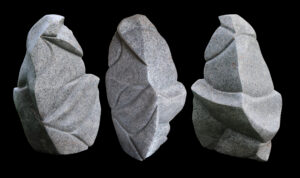
Ivresse 1 dimensions :37x19x18 cm ; poids : 15,0 Kg.
Nom : roche du vignoble de Fitou !
« Ivresse 2 », ‘Drunkenness’ 2. Syénite à néphéline de Fitou, Aude, France

Ivresse 2 dimensions : ~32x28x14 cm ; poids : 19,3 Kg.
Name: rock from the Fitou vineyard!
Galerie virtuelle de Jean-Pierre MILESI, Artiste contemporain / http://www.artabus.com/milesijpgmai
Sélection sur : https://www.artlimited.net/milesijp
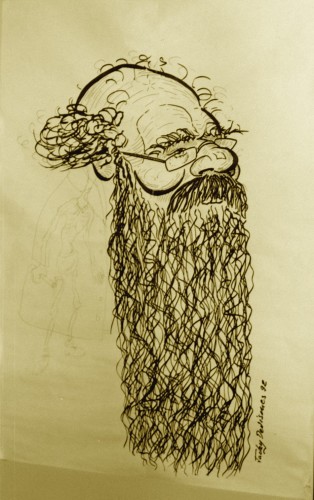
Les commentaires sont fermés.